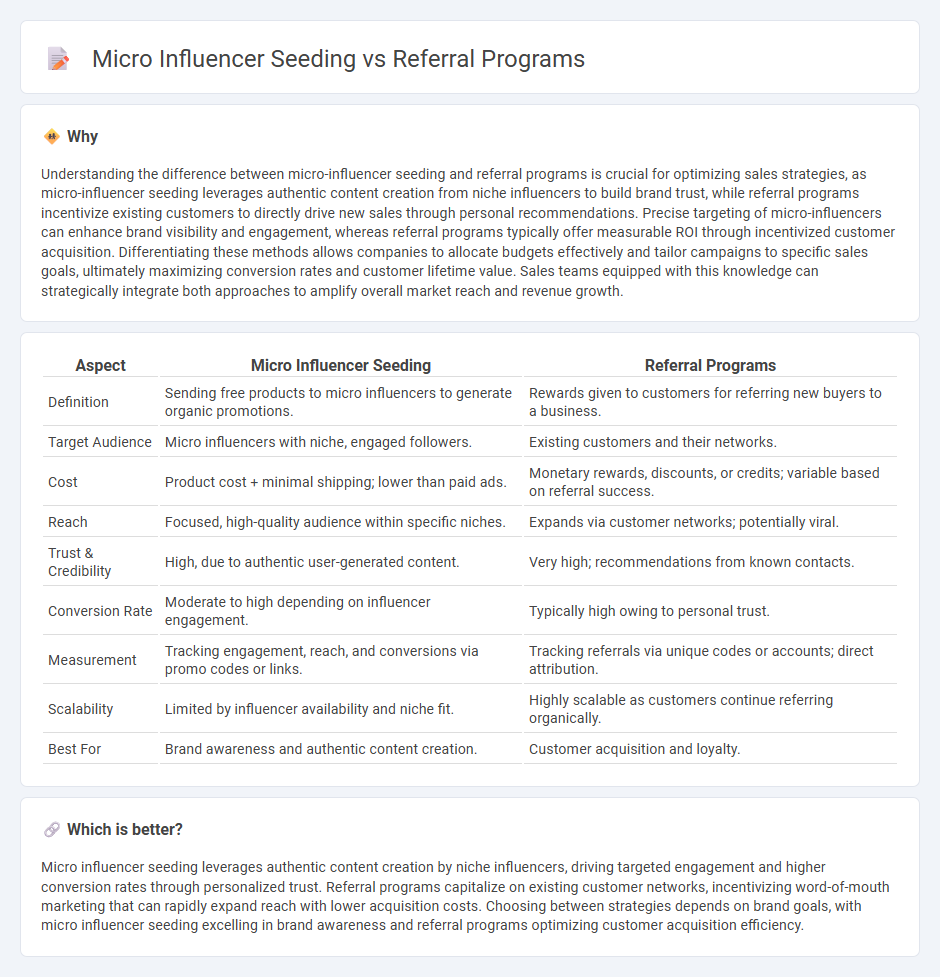
Micro influencer seeding leverages authentic content creators to organically promote brands, boosting engagement with niche audiences and enhancing brand credibility. Referral programs incentivize existing customers to recommend products, driving high-conversion leads through trusted personal connections and expanding the customer base cost-effectively. Discover how combining micro influencer seeding and referral programs can amplify your sales strategy.
Why it is important
Understanding the difference between micro-influencer seeding and referral programs is crucial for optimizing sales strategies, as micro-influencer seeding leverages authentic content creation from niche influencers to build brand trust, while referral programs incentivize existing customers to directly drive new sales through personal recommendations. Precise targeting of micro-influencers can enhance brand visibility and engagement, whereas referral programs typically offer measurable ROI through incentivized customer acquisition. Differentiating these methods allows companies to allocate budgets effectively and tailor campaigns to specific sales goals, ultimately maximizing conversion rates and customer lifetime value. Sales teams equipped with this knowledge can strategically integrate both approaches to amplify overall market reach and revenue growth.
Comparison Table
| Aspect | Micro Influencer Seeding | Referral Programs |
|---|---|---|
| Definition | Sending free products to micro influencers to generate organic promotions. | Rewards given to customers for referring new buyers to a business. |
| Target Audience | Micro influencers with niche, engaged followers. | Existing customers and their networks. |
| Cost | Product cost + minimal shipping; lower than paid ads. | Monetary rewards, discounts, or credits; variable based on referral success. |
| Reach | Focused, high-quality audience within specific niches. | Expands via customer networks; potentially viral. |
| Trust & Credibility | High, due to authentic user-generated content. | Very high; recommendations from known contacts. |
| Conversion Rate | Moderate to high depending on influencer engagement. | Typically high owing to personal trust. |
| Measurement | Tracking engagement, reach, and conversions via promo codes or links. | Tracking referrals via unique codes or accounts; direct attribution. |
| Scalability | Limited by influencer availability and niche fit. | Highly scalable as customers continue referring organically. |
| Best For | Brand awareness and authentic content creation. | Customer acquisition and loyalty. |
Which is better?
Micro influencer seeding leverages authentic content creation by niche influencers, driving targeted engagement and higher conversion rates through personalized trust. Referral programs capitalize on existing customer networks, incentivizing word-of-mouth marketing that can rapidly expand reach with lower acquisition costs. Choosing between strategies depends on brand goals, with micro influencer seeding excelling in brand awareness and referral programs optimizing customer acquisition efficiency.
Connection
Micro influencer seeding leverages targeted product placements to authentic audiences, enhancing brand visibility and trust through genuine endorsements. Referral programs incentivize existing customers or micro influencers to promote products, creating a collaborative sales network that amplifies word-of-mouth marketing. Together, these strategies drive customer engagement and boost conversion rates by combining organic reach with personalized incentives.
Key Terms
Referral programs:
Referral programs leverage existing customers to drive new leads by rewarding successful recommendations, resulting in higher trust and conversion rates compared to traditional marketing. These programs track referrals through unique codes or links, enabling precise ROI measurement and scalability for businesses of all sizes. Explore how implementing a referral program can significantly boost customer acquisition and lifetime value.
Incentives
Referral programs offer direct, often monetary incentives to participants who successfully bring in new customers, boosting engagement through clear, rewarding structures. Micro influencer seeding relies on gifting products or exclusive experiences to niche content creators, incentivizing authentic promotions without traditional payment. Explore how optimizing incentives in each strategy can amplify customer acquisition and brand loyalty.
Customer Advocacy
Referral programs leverage existing customers to advocate brand loyalty through incentivized word-of-mouth, driving higher conversion rates and trust. Micro influencer seeding focuses on collaboration with niche influencers to amplify authentic brand messages within targeted communities, enhancing reach and engagement. Explore how these strategies uniquely fuel customer advocacy and boost brand growth.
Source and External Links
How to build a customer referral program in 2025 - Referral programs encourage customer advocacy and loyalty with rewards for referrers and new customers; examples include Google Workspace offering cash rewards and T-Mobile providing prepaid cards for referrals.
20+ Best Referral Programs to Make Money in 2025 - Lists top referral programs from companies like GetResponse, Dropbox, Fiverr, Tesla, and T-Mobile with rewards ranging from cash, discounts, gift cards, or credits for each successful referral.
How to Build a Great Referral Program in 2025 (+23 Examples) - Defines referral programs as marketing strategies that reward customers for referring new buyers, emphasizing increased acquisition and loyalty with software-led tools to facilitate sharing and rewards.
 dowidth.com
dowidth.com